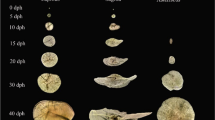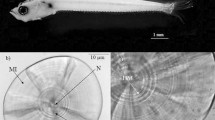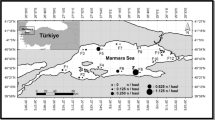Abstract
To apply otolith microstructure to examination of age and growth of juvenile chum salmon Oncorhynchus keta inhabiting coastal waters, formation of otolith increments was investigated for juveniles reared in a seawater aquarium and in net pens. In all otoliths examined, a distinctive check was formed at the time of sea entry of the fish. The deposition of otolith increments after the check was daily for rearing both in the aquarium (57 days) and in the net pens (26 days). Check formation associated with sea entry was also observed in otoliths of juvenile salmon collected 1 km off the coast of Shari, Hokkaido, Japan. Transmitted light observation of otoliths of those fish revealed a transition in otolith increment appearance from dark to light. Otolith Sr: Ca ratio remarkably changed from a low to a high level, coinciding with the transition in otolith appearance. It is suggested that the transition was associated with individual sea entry. This study demonstrated that the check and/or transition associated with sea entry are applicable to a benchmark for otolith increment counts of juvenile chum salmon inhabiting coastal waters.
Similar content being viewed by others
References
Secor DH, Dean JM, Campana SE. Recent Developments in Fish Otolith Research. University of South Carolina Press, Columbia, SC, 1995.
Campana SE. Accuracy, precision and quality control in age determination, including a review of the use and abuse of age validation methods. J. Fish Biol. 2001; 59: 197–242.
Wilson KH, Larkin PA. Daily growth rings in the otoliths of juvenile sockeye salmon (Oncorhynchus nerka). Can. J. Fish. Aquat. Sci. 1980; 37: 1495–1498.
Marshall SL, Parker SS. Pattern identification in the microstructure of sockeye salmon on (Oncorhynchus nerka) otoliths. Can. J. Fish. Aquat. Sci. 1982; 39: 542–547.
Campana SE. Calcium deposition and otolith check formation during periods of stress in coho salmon, Oncorhynchus kisutch. Comp. Biochem. Physiol. 1983; 75A: 215–220.
Neilson JD, Geen GH. Otoliths of chinook salmon (Oncorhynchus tshawytscha): daily growth increments and factors influencing their production. Can. J. Fish. Aquat. Sci. 1982; 39: 1340–1347.
Volk EC, Wissmar RC, Simenstad CA, Eggers DM. Relationship between otolith microstructure and the growth of juvenile chum salmon (Oncorhynchus keta) under different prey rations. Can. J. Fish. Aquat. Sci. 1984; 41: 126–133.
Fukuwaka M. Allometric back-calculation of individual growth for chum salmon otolith during early life. Sci. Rep. Hokkaido Salmon Hatchery 1996; 50: 113–116.
Tsukamoto K, Seki Y, Oba T, Oya M, Iwahashi M. Application of otolith to migration study of salmonids. Physiol. Ecol. Jpn. 1989; 1: 119–140.
Nishimura A, Hatakeyama M. Daily growth increments in the otolith of masu salmon, Oncorhynchus masou. Sci. Rep. Hokkaido Fish Hatchery 1992; 46: 9–16.
Volk EC, Mortensen DG, Wertheimer AC. Nondaily otolith increments and seasonal changes in growth of a pink salmon (Oncorhynchus gorbuscha) population in Auke Bay, Alaska. In: Secor DH, Dean JM, Campana SE (eds). Recent Developments in Fish Otolith Research. University of South Carolina Press, Columbia, SC. 1995; 211–225.
Zhang Z, Beamish RJ, Riddell BE. Differences in otolith microstructure between hatchery-reared and wild chinook salmon (Oncorhynchus tshawytscha). Can. J. Fish. Aquat. Sci. 1995; 52: 344–352.
Campana SE, Neilson JD. Microstructure of fish otoliths. Can. J. Fish. Aquat. Sci. 1985; 42: 1014–1032.
Neilson JD, Geen GH, Bottom D. Estuarine growth of juvenile chinook salmon (Oncorhynchus tshawytscha) as inferred from otolith microstructure. Can. J. Fish. Aquat. Sci. 1985; 42: 899–908.
Zhang Z, Beamish RJ. Use of otolith microstructure to study life history of juvenile chinook salmon in the Strait of Georgia in 1995 and 1996. Fish. Res. 2000; 46: 239–250.
Kaeriyama M. Hatchery programmes and stock management of salmonid populations in Japan. In: Howell BR, Moksness E, Svåsand T (eds). Stock Enhancement and Sea Ranching. Blackwell Science, Oxford. 1999; 153–167.
Kaeriyama M. Dynamics of chum salmon, Oncorhynchus keta, populations released from Hokkaido, Japan. N. Pac. Anadr. Fish Comm. Bull. 1998; 1: 90–102.
National Salmon Resources Center. Changes in fry releases. adult returns, and return rates of chum salmon. [Cited 23 June 2005] Available from URL: http://www.salmon.affrc.go.jp/zousyoku/ok_relret.htm/ (in Japanese).
Kobayashi T, Harada S, Abe S. Ecological observations on the salmon of Nishibetsu River 1: the migration and growth of chum salmon fry, Oncorhynchus keta (Walbaum). Sci. Rep. Hokkaido Salmon Hatchery 1965; 19: 1–10.
Mayama H, Kato M, Seki J, Shimizu I. Studies on the chum salmon released in the Ishikari River system-I: on the seaward migration and inshore distribution of liberated fry in 1979. Sci. Rep. Hokkaido Salmon Hatchery 1982; 36: 1–17.
Mayama H, Seki J, Shimizu I. Studies on the chum salmon released in the Ishikari River system-II. on the seaward migration and inshore distribution of liberated fry in 1980 and 1981. Sci. Rep. Hokkaido Salmon Hatchery 1983; 37: 1–22.
Irie T. Ecological studies on the migration of juvenile chum salmon, Oncorhynchus keta, during early ocean life. Bull. Seikai Natl. Fish. Res. Inst. 1990; 68: 1–142.
Kalish JM. Use of otolith microchemistry to distinguish the progeny of sympatric anadromous and non-anadromous salmonids. Fish. Bull. 1990; 88: 657–666.
Otake T, Uchida K. Application of otolith microchemistry for distinguishing between amphidromous and non-amphidromous stocked ayu, Plecoglossus altivelis. Fish. Sci. 1998; 64: 517–521.
Campana SE. Chemistry and composition of fish otoliths: pathways, mechanisms and applications. Mar. Ecol. Prog. Ser. 1999; 188: 263–297.
Arai T. Migratory history of fishes: present status and perspectives of the analytical methods. Jpn. J. Ichthyol. 2002; 49: 1–23.
Jones C. Determining age of larval fish with the otolith increment technique. Fish. Bull. 1986; 84: 91–103.
Sokal RR, Rohlf FJ. Biometry: The Principles and Practice of Statistics in Biological Research, 3rd edn. W.H. Freeman, New York. 1995.
Mugiya Y. Otolith formation and reading in teleosts. In: Wada K, Kobayashi I (eds). Biomineralization and Hard Tissue of Marine Organisms. Tokai University Press, Tokyo. 1996; 285–298.
Mosegaard H, Svedäng H, Taberman K. Uncoupling of somatic and otolith growth rates in Arctic char (Salvelinus alpinus) as an effect of differences in temperature response. Can. J. Fish. Aquat. Sci. 1988; 45: 1514–1524.
Volk EC, Blakley A, Schroder SL, Kuehner SM. Otolith chemistry reflects migratory characteristics of Pacific salmonids: using otolith core chemistry to distinguish maternal associations with sea and freshwaters. Fish. Res. 2000; 46: 251–266.
Zimmerman CE, Reeves GH. Identification of steelhead and resident rainbow trout progeny in the Deschutes River, Oregon, revealed with otolith microchemistry. Trans. Am. Fish. Soc. 2002; 131: 986–993.
Author information
Authors and Affiliations
Corresponding author
Rights and permissions
About this article
Cite this article
Saito, T., Kaga, T., Seki, J. et al. Otolith microstructure of chum salmon Oncorhynchus keta: formation of sea entry check and daily deposition of otolith increments in seawater conditions. Fish Sci 73, 27–37 (2007). https://doi.org/10.1111/j.1444-2906.2007.01298.x
Received:
Accepted:
Issue Date:
DOI: https://doi.org/10.1111/j.1444-2906.2007.01298.x




